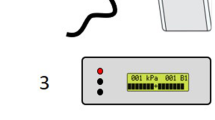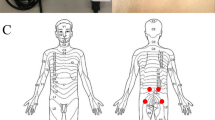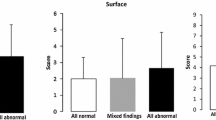Abstract
Purpose
Pressure algometry is widely used to obtain measures of mechanical pain sensitivity in adults, both in experimental and clinical pain conditions. Only very few studies describe the use of pressure algometry in children. The purpose of this study was to produce reference values of pressure pain thresholds and to determine the intra- and interrater agreement, in order to introduce pressure algometry as a standardized method for the assessment of pain thresholds in children with orthopedic disorders.
Methods
Pressure pain thresholds were determined at the leg and at the thenar in 50 children aged 4–12 years. All were scheduled for physical examination at the outpatient Orthopedic Clinic at Aarhus University Hospital, Denmark, because of various orthopedic disorders such as clubfoot and Baker’s cyst. Pressure pain thresholds were determined by two different raters: 20 children were examined twice by rater 1 (intrarater agreement), and another 20 children were examined by both rater 1 and rater 2 (interrater agreement). An additional ten children were examined once by rater 1 to increase the number of children used to determine the reference values.
Results
The pressure pain threshold was 183.1 kPa (mean, SD: 90.7) at the leg and 179.1 kPa (mean, SD: 97.4 kPa) at the thenar (n = 50). Pressure pain thresholds were similar in boys (n = 27) and girls (n = 23). Also, pressure pain thresholds were not affected by age. Bland–Altman plots showed excellent intrarater agreement and satisfactory interrater agreement.
Conclusion
Pressure algometry has excellent intrarater agreement and satisfactory interrater agreement. Pressure algometry was well-tolerated even by very young children. The method deserves more widespread use both in clinical and experimental settings.




Similar content being viewed by others
References
Rolke R, Baron R, Maier C, Tolle TR, Treede RD, Beyer A, Binder A, Birbaumer N, Birklein F, Botefur IC, Braune S, Flor H, Huge V, Klug R, Landwehrmeyer GB, Magerl W, Maihofner C, Rolko C, Schaub C, Scherens A, Sprenger T, Valet M, Wasserka B (2006) Quantitative sensory testing in the German research network on neuropathic pain (DFNS): standardized protocol and reference values. Pain 123:231–243
Arendt-Nielsen L, Nie H, Laursen MB, Laursen BS, Madeleine P, Simonsen OH, Graven-Nielsen T (2010) Sensitization in patients with painful knee osteoarthritis. Pain 149:573–581
Kosek E, Ekholm J, Hansson P (1996) Sensory dysfunction in fibromyalgia patients with implications for pathogenic mechanisms. Pain 68:375–383
Baad-Hansen L, Leijon G, Svensson P, List T (2008) Comparison of clinical findings and psychosocial factors in patients with atypical odontalgia and temporomandibular disorders. J Orofac Pain 22:7–14
Kasch H, Qerama E, Kongsted A, Bach FW, Bendix T, Jensen TS (2008) Deep muscle pain, tender points and recovery in acute whiplash patients: a 1-year follow-up study. Pain 140:65–73
Hashkes PJ, Friedland O, Jaber L, Cohen HA, Wolach B, Uziel Y (2004) Decreased pain threshold in children with growing pains. J Rheumatol 31:610–613
Uziel Y, Chapnick G, Jaber L, Nemet D, Hashkes PJ (2010) Five-year outcome of children with “growing pains”: correlations with pain threshold. J Pediatr 156:838–840
Fernandez-Mayoralas DM, Fernandez-de-las-Penas C, Ortega-Santiago R, Ambite-Quesada S, Jimenez-Garcia R, Fernandez-Jaen A (2010) Generalized mechanical nerve pain hypersensitivity in children with episodic tension-type headache. Pediatrics 126:187–194
Hogeweg JA, Kuis W, Oostendorp RA, Helders PJ (1996) The influence of site of stimulation, age, and gender on pain threshold in healthy children. Phys Ther 76:1331–1339
Chaves TC, Nagamine HM, de Sousa LM, de Oliveira AS, Grossi DB (2007) Intra- and interrater agreement of pressure pain threshold for masticatory structures in children reporting orofacial pain related to temporomandibular disorders and symptom-free children. J Orofac Pain 21:133–142
Chaves TC, Nagamine HM, de Sousa LM, de Oliveira AS, Grossi DB (2010) Comparison between the reliability levels of manual palpation and pressure pain threshold in children who reported orofacial pain. Manual therapy 15:508–512
Ohrbach R, Gale EN (1989) Pressure pain thresholds, clinical assessment, and differential diagnosis: reliability and validity in patients with myogenic pain. Pain 39:157–169
Chung SC, Kim JH, Kim HS (1993) Reliability and validity of the pressure pain thresholds (PPT) in the TMJ capsules by electronic algometer. Cranio 11:171–176
Antonaci F, Sand T, Lucas GA (1998) Pressure algometry in healthy subjects: inter-examiner variability. Scand J Rehabil Med 30:3–8
Chesterton LS, Sim J, Wright CC, Foster NE, Chesterton LS, Barlas P, Foster NE, Baxter GD, Wright CC (2007) Interrater reliability of algometry in measuring pressure pain thresholds in healthy humans, using multiple raters. Clin J Pain 23:760–766
Meeus M, Roussel NA, Truijen S et al (2010) Reduced pressure pain threshold in response to exercise in chronic fatigue syndrome but not in chronic low back pain: An experimental study. J Rehabil Med 42:884–890
Bland JM, Altman DG (1986) Statistical methods for assessing agreement between two methods of clinical measurement. Lancet 1:307–310
Persson AL, Brogardh C, Sjolund BH (2004) Tender or not tender: test–retest repeatability of pressure pain thresholds in the trapezius and deltoid muscles of healthy women. J Rehabil Med 36:17–27
Kallai I, Barke A, Voss U (2004) The effects of experimenter characteristics on pain reports in women and men. Pain 112:142–147
Aslaksen PM, Myrbakk IN, Hoifodt RS, Flaten MA (2007) The effect of experimenter gender on autonomic and subjective responses to pain stimuli. Pain 129:260–268
Lautenbacher S, Kunz M, Strate P, Nielsen J, Arendt-Nielsen L (2005) Age effects on pain thresholds, temporal summation and spatial summation of heat and pressure pain. Pain 115:410–418
Chesterton LS, Barlas P, Foster NE, Baxter GD, Wright CC (2003) Gender differences in pressure pain threshold in healthy humans. Pain 101:259–266
Goubert L, Vervoort T, Cano A, Crombez G (2009) Catastrophizing about their children`s pain is related to higher parent–child congruency in pain ratings: an experimental investigation. Eur J Pain 13:196–201
Acknowledgments
This work was supported in part by a grant from Agustinus Fonden.
Author information
Authors and Affiliations
Corresponding author
About this article
Cite this article
Nikolajsen, L., Kristensen, A.D., Pedersen, L.K. et al. Intra- and interrater agreement of pressure pain thresholds in children with orthopedic disorders. J Child Orthop 5, 173–178 (2011). https://doi.org/10.1007/s11832-011-0336-4
Received:
Accepted:
Published:
Issue Date:
DOI: https://doi.org/10.1007/s11832-011-0336-4




